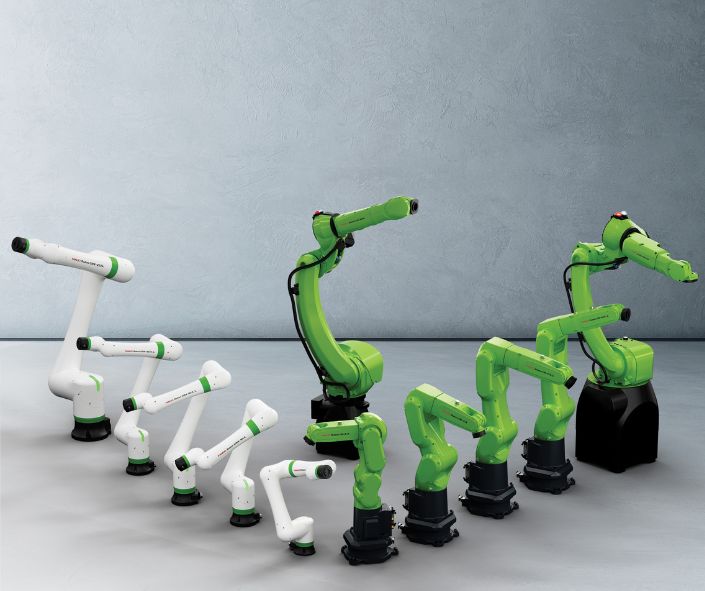

Collaborative Robots | Seamless Human and Robot Collaboration
In the evolving landscape of industrial automation, collaborative robots, or cobots, mark a transformative era. Previously, industrial automation has been confined to isolated areas, with robots working in spaces cordoned off from human interaction. The concept of being near an active robot was once inconceivable. However, the market has since embraced cobots, which utilise force sensors and machine vision among other technologies to prevent hitting humans or to automatically shut down if a collision occurs..
Many modern manufacturers now embrace the integration of collaborative robots. Thus allowing workers to collaborate with these machines as seamlessly as they would with their own human colleagues.
Collaborative Robots | A Historical Overview
The concept of collaborative robots was initially sparked by a research project led by the General Motors Foundation in 1995, which aimed to explore the potential for robots to safely collaborate with humans in shared environments. Consequently, this led to the development of the first cobot.
When it comes to FANUC collaborative robots, the variety we exclusively integrate at ASA, it was 2015 when their first collaborative robot was introduced to the marketplace. Having worked with industrial robots since 1956, this was ground breaking for a company that had become a top industrial robot manufacturer throughout the world.The FANUC CR-15ia, was FANUC’s first robot designed to work side by side with humans without the need for barriers, thanks to its advanced safety sensors, rounded corners, and soft outer shell. Then, a few years after this, FANUC became the pioneering manufacturer to commit an entire product line exclusively to collaborative robots.


Collaborative Robots V Industrial Robots
The distinction between collaborative robots and traditional industrial robots is becoming clearer as cobots gain popularity in various production environments. Here are key differences between collaborative robots and Industrial Robots:
Safety and Intelligence: Engineers design collaborative robots with safety and intelligence in mind, outfitting them with advanced sensors and visual technology to detect and respond to humans, thus eliminating the need for protective barriers.
Human-Robot Collaboration: Unlike autonomous industrial robots, cobots are designed to work alongside humans, thereby enhancing productivity and efficiency.
Ease of Programming: Collaborative robots are user-friendly and adaptable.Thus requiring no specialised programming skills.
Collaborative Robots | Collaborative Robot Applications
With their advanced sensors and mobility, they can operate in a vast array of environments. So collaborative robots are a natural fit in a diverse range of industries and applications. Shift from high-mix low volume to low mix and high volume task easily. In addition, with a wide range of end of arm tooling (EOAT) it is simple for a collaborative robot to switch tasks as well. Thus from the metal industry, electronics industry, through to the food industry and automotive industry (and many more), collaborative robots are changing manufacturing floors.
Collaborative robots are not just flexible and user-friendly; they are also instrumental in safeguarding workers from hazardous tasks and minimising workplace accidents. Their versatility allows them to undertake a wide array of roles across numerous industries, proving invaluable in tasks like packaging, assembly, machine tending, and palletising.


Not All Collaborative Robots are Created Equal
When it comes to entrusting your production and manufacturing processes to a product, FANUC represents a wise investment. As a result, FANUC have produced 750,000+ robots, recognised as the global frontrunner in automation solutions. FANUC Cobots are compact, quick to implement, and easy to program, with renowned reliability. FANUC’s Collaborative Robot range including the CRX and the CRiA Series show case an extensive array of options, a higher payload capacity, extended reach, and increased speed when compared with others on the market.
Lets Collaborate! Get in Touch, Today!
ASA is your ideal Collaborative Robot integrator. When it comes to collaborative robots in Australia, our team at ASA are FANUC robot integration specialists, from concept to system designs, installations, programming and support. Automated Solutions Australia (ASA) thrive on helping Australian business of all sizes achieve their automation goals. This helps Australian companies to compete on the world stage. When it comes to your cobot needs, Automated Solutions Australia are your Australian experts.


Send an enquiry:
Click an Application to Explore Further:
FANUC Robots Australia | Paint Robots for Surface Finishing | Welding Robots by FANUC | Machine Tool Tending Robots | Fibreglass and Gelcoat Robots | Palletising Robots | Robotic Vision Inspection Systems | Plastics Painting | Deburring and Polishing | Sealing and Dispensing | Picking and Packaging | Material Removal Robots | Shot Blasting and Peening |


